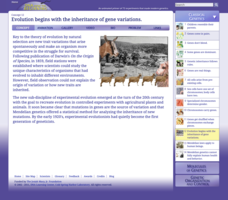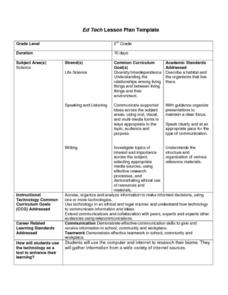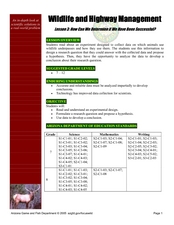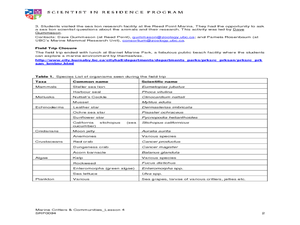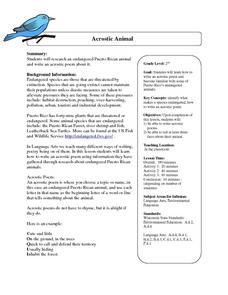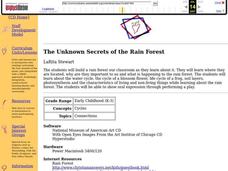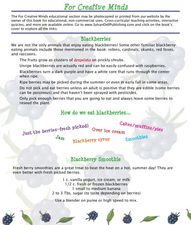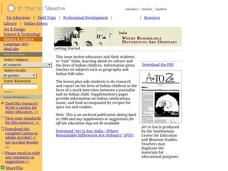Polar Trec
Plankton Parents
Plankton are so abundant in the ocean they outweigh all of the animals in the sea. In this three day activity, groups discuss and become familiar with plankton, capture females, and look for egg production on day three.
ReadWriteThink
The Chinese New Year Starts Today
As part of a celebration of Chinese New Year, class members research the Chinese zodiac and examine the description of the personality attributes associated with the animal of their birth year. Individuals then craft a persuasive essay...
Serendip
Evolution of Fur Color in Mice – Mutation, Environment and Natural Selection
Most species of animals include a variety of fur or hair color, but why? Scholars watch a video about a changing environment for mice. As the rocks around them change hues, different colors of mice begin to thrive. Discussion questions...
Cold Spring Harbor Laboratory
Evolution Begins with the Inheritance of Gene Variations
Connect Mendelian genetics with Darwinian theories. An interactive lesson lets pupils explore how George Shull used research from other scientists to explore genetic variation. The resource outlines the statistical analysis of genetic...
Reed Novel Studies
Redwall: Novel Study
Many dream of a place of refuge to escape from the harsh world. That is exactly what Redwall is for the creatures of the forest. Redwall is a fantasy novel that tells of the trouble that comes to a quiet and peaceful forest....
Curated OER
Organisms and Habitats
Second graders investigate biomes and the plants and animals that are native to particular biomes. They participate in a class discussion, conduct Internet research on a selected biome, and create a shoebox biome using their Internet...
Curated OER
Strawberry Girl: Outdoors in Florida
Young scholars explore nature by researching the state of Florida. In this animal identification lesson, students read a children' story and research the Internet to discover the difference in animal life between the early 1900's and...
Curated OER
Food Webs
Young scholars research an animal to define its food web and life cycle. In this animal life cycle lesson, students research an animal and define its food web. Young scholars then present their animal food webs to the class and note...
Curated OER
Under The Sea
In this resource lesson plan, young scholars use non-fiction books to research ocean animals. Students discover the many features of non-fiction books and how to use these features to help them conduct research. Young scholars then...
Curated OER
Elephants
Learners research an elephant habit and present their findings to the class. In this elephant lesson plan, students also answer short answer questions about elephant characteristics and features.
Curated OER
Wildlife and Highway Management
Students create a research questions about animal underpasses and how animals use them. In this animals lesson plan, students use their collected data to answer their question.
Curated OER
Life Cycles
Using computers, Students work in small groups and progress through the roles of Explorer, Researcher, Designer, and Evaluator as they study the life cycle of plants, insects, butterflies and frogs.
Curated OER
Wildlife Study Comparison
Pupils compare/contrast two studies that examine the effects of environmental contaminants on animals. They read an article, identify the components of a research study, summarize the article, and complete a matrix.
Curated OER
Marine Critters and Communities
Students touch, see, smell, and hear marine animals that live in a marina. In this marine animals lesson plan, students take field trip to a marine environment after studying the animals.
Curated OER
Critter Museum
Learners act as directors of a new science museum where they have decided to set up a display of animals without backbones that are found in the area. To organize their display, they need to sort and classify a collection of animals and...
Curated OER
Acrostic Animal
Second graders listen as the teacher describes how an acrostic poem is written. They research an endangered animal of Puerto Rico. Students write an acrostic poem as a class, and then individually about the animal they research. Students...
Curated OER
Where Have All the Endangered Gone?
Students explore animals that are endangered. They choose an endangered animal that they would like to keep from becoming extinct. Students create a persuasive presentation to persuade someone to understand why they feel keeping their...
Curated OER
The Unknown Secrets of the Rain Forest
Students listen to the story "The Great Kapok" then discuss characteristics of the rain forest. They make several different types of rain forest animals from paper plates (ex. sloth, tigers, monkeys etc) and design costumes for a...
Curated OER
Understanding the Power of Genes
Students research the impacts of genetic research on homes, research laboratories, and hospitals. In this genetics lesson, students use the Internet to investigate the ways that genetics has affected our way of life. They present...
Curated OER
Blackberries
Students read and answer questions about other animals that like blackberries besides humans. In this blackberries lesson plan, students read about what animals like to eat blackberries and what they do for them.
Curated OER
Big Cat Classification
First graders discover the different names and classifications of big cats by using word processing applications. In this animal life lesson, 1st graders investigate one big cat and create a database of facts about it using an word...
Curated OER
Vertebrates are Cool!
Students conduct research on various vertebrates. They read the eBook 'Vertebrates,' select a vertebrate, conduct research, and create an eBook with one photo about their chosen vertebrate.
Curated OER
India: Where Remarkable Differences Are Ordinary
Students research India and Indian culture. In this Indian research lesson plan, students research and report on the lives of Indian children. The report will be in the form of a mock interview between a journalist and an Indian child....
Curated OER
Keys and Classifying
Students classify plants and animals. In this organisms lesson, students define classification and sort various objects according to its attributes. Students then research wildlife of Utah and group the organisms into categories.



